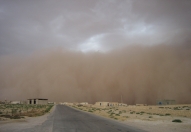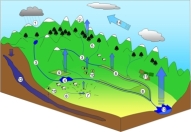Prof. Jason P. Evans
Climate Change Research Centre
University of New South Wales









|
My research is centered around issues in regional climate and water resources. I have a strong background in mathematics and hence much of my research has involved development and application of modelling tools. My current research involves questions about the regional impacts of changes in climate - both past and future - and the strength of the interaction between the land surface and atmosphere. My main interests include modeling regional climate, projections of regional climate extremes, changing climate impacts on water quantity and changing land use impacts on water. CORDEX-AustralAsia CORDEX (Coordinated Regional Climate Downscaling Experiment) is an international project providing global coordination of Regional Climate Downscaling for improved regional climate change adaptation and impact assessment. I am lead of the CORDEX-AustralAsia domain. This project is focused on downscaling CMIP5 Global Climate Model simulations and, along with NARCliM, will provide the most comprehensive regional scale climate projections to date. Local climate changes caused by large bushfire burnt areas This project aims to quantify the impact on local climate produced by large burnt areas after extreme bushfires. This project expects to generate new knowledge on these previously unexplored fire-scar induced changes to local climate. It will extend an innovative approach that combines satellite based earth observation with very high resolution regional climate modelling to quantify the impacts on land-atmosphere feedbacks and local climate. Expected outcomes of this project include enhanced methods to quantify local climate changes after extreme fires and their effect on vegetation recovery. This should provide significant benefits to the planning for, and management of, vegetation recovery after extreme fires. Understanding extreme wind gusts and associated risks in NSW Wind gusts are rare bursts of high wind, often associated with thunderstorm outflows. They can do significant structural damage, and their rarity and small scale make prediction and risk assessment difficult. This proposal seeks to better understand and predict wind gusts and their impacts to aid in planning. The project aims to use past observations, modelling, and basic theory to show what conditions lead to wind gusts and how likely they are to exceed key thresholds. It targets important scientific and practical issues such as the joint occurrence of gusts and high rainfall, role of gusts in contributing to dust and other airborne pollutants, impacts of gusts on subsequent storm activity, and gusts in a warming climate. Regional climate change guidance for local action This project is part of the Climate Systems Hub of the National Environmental Science Program. The project will deliver enhanced methods, data and understanding to increase confidence around changes to hazards and extremes at regional to local scales. The improved confidence comes from multiple components - including enhanced process representation in projections from climate models, and statistical methods employed when using that model data. The project will focus on the hazards of extreme rainfall (including associated flood risk factors), extreme wind (including damaging wind gusts from storms) and extreme heat (including related fire weather extremes). The project will be informed and implemented through co-design to connect stakeholder adaptation needs to applied science, and inform the underpinning science development. NSW / ACT Regional Climate Modelling (NARCliM) project NARCliM produced an ensemble of regional climate projections over south-east Australia in collaboration with the NSW government Office of Environment and Heritage. These simulations have been used to investigate regional climate processes and their future changes, as well as facilitating climate change impacts and adaptation research. The NSW Department of Planning and Environment (DPE) are currently produicing new updated regional projections - NARCliM2 Other research I have been involved with
|
|